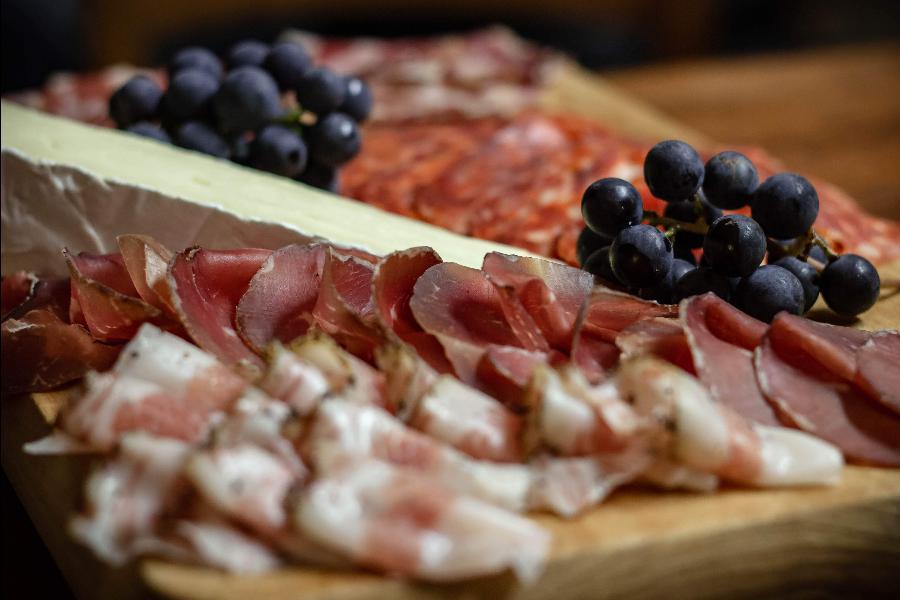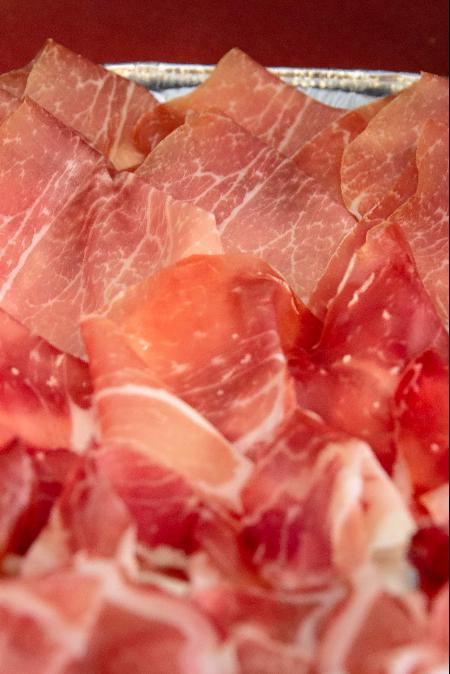I’ve tasted antipasto platters across Italy—from the hilltop towns of Umbria to the salty shores of Sicily—and after hundreds of shared boards, I’ve come to appreciate how misunderstood these terms are outside Italy.
Antipasto is singular. Antipasti is plural. Antipasta is a mistaken word—commonly used, but incorrect in Italian.
When people refer to “antipasta,” they often mean “antipasto” or “antipasti,” but the confusion is understandable, especially when you hear it sputtered or read it without context. I’ve made the same mistake myself early on.
This article breaks down what each term really means, how Italians use them, and why this matters if you’re building a proper antipasti board, mainly if it includes cured meats and salumi.
What Do Antipasto, Antipasti, and Antipasta Really Mean?

These terms come from the same Latin roots but mean slightly different things depending on grammar.
Antipasto (Singular)
Antipasto literally means “before the meal” (anti = before, pasto = meal). It’s the singular form, referring to one plate, one serving, or one type of appetizer.
If you were served a single dish of marinated artichokes and cured ham at a trattoria, that would be your antipasto.
Antipasti (Plural)
Antipasti is the plural form of antipasto. It means multiple appetizers or a shared spread of different small plates at the start of a meal.
It’s what you’d call a board or platter with salumi, cheese, olives, and preserved vegetables—all served together for the table. Most of what we call “antipasto platters” are technically antipasti.
Antipasta (Incorrect)
Antipasta is a mix-up. It doesn’t exist in proper Italian, but it’s commonly used in English-speaking countries. Likely, it’s confused with “pasta,” since that’s what many people associate with Italian meals. I’ve seen it on menus and even product labels outside Italy.
To be clear: antipasta is not a real word in Italian. If you’re visiting Italy, using it will raise a few eyebrows—but locals are usually kind about it.
Why Antipasti Is About More Than Just Appetizers
Antipasti isn’t just about food—it’s about **ritual**. It sets the tone for a meal. It’s how Italians say: slow down, share something simple, and enjoy what’s to come.
Whether at a family table in Parma or a countryside bar in Puglia, I’ve found antipasti to be a moment of connection. You break bread, sip wine, and pass plates. You don’t rush. It’s about **starting with presence**, not just filling space before the “main.”
Sharing to Break the Ice
I’ve always loved that it brings people together. There’s something about reaching for the same plate of salumi that drops everyone’s guard. It’s communal, not transactional—and it always gets people talking.
What Belongs on a Traditional Antipasti Board?
There’s a world of antipasti variation across Italy, but a few timeless ingredients form the foundation. Across dozens of shared tables, I’ve seen these elements again and again.
- Salumi (dry-cured meats like prosciutto, coppa, pancetta, or salami)
- Cheeses (from fresh mozzarella to sharp Parmigiano-Reggiano)
- Marinated vegetables (artichokes, courgettes, mushrooms, peppers)
- Olives (typically soaked in extra virgin olive oil)
- Crusty bread or crostini (sometimes rubbed with garlic or olive oil)
It’s not about excess. It’s about balance — fat and acid, softness and crunch. The cured meats often take the spotlight, and for good reason. If you want a breakdown of what meats belong on a traditional board, I’ve written about that in detail here.
How I Build a Balanced Antipasti Spread
At home or abroad, I always try to build a plate that does justice to the Italian idea of balance. Here’s a typical combo I put together:
| Meat | Cheese | Vegetable |
| Prosciutto di Parma | Pecorino Toscano | Marinated artichokes |
| Coppa | Qualty Cheese | Olives with fresh herbs |
| Salami | Parmigiano-Reggiano | Grilled courgette slices |
Serve that with a bold red wine or even a sparkling Lambrusco, and you’re set.
As Delallo explains, antipasti isn’t just a course — it’s a way to welcome people, break the ice, and create connection. The platter itself becomes part of the experience.
Antipasto in the Structure of an Italian Meal
In a formal Italian meal, antipasto is the first plate to hit the table after the aperitivo. It sets the tone for everything that follows. But don’t confuse “starter” with “small.” Italians go big on antipasti.
- Aperitivo: pre-dinner drink and nibbles
- Antipasto: appetizer or shared cold plate
- Primo: pasta, risotto, or soup
- Secondo: main dish, usually meat or fish
- Contorno: vegetable side
- Dolce: dessert
- Caffè: espresso, no milk
- Digestivo: after-dinner liqueur
It’s a sequence that’s designed to build slowly — and the antipasto is a gentle opening act. According to Wikipedia’s Italian meal structure, this layered approach reflects centuries of food tradition and social custom.
From my experience, antipasto is where the real enjoyment begins. By the time the primo arrives, everyone’s already smiling, chewing, and sipping their second glass of wine.
Regional Antipasti Variations Across Italy
What makes antipasti so interesting is how much it changes depending on where you are in Italy. Every region has its own traditions, ingredients, and presentation style — shaped by local geography, culture, and climate.
Northern Italy
In Northern Italy — especially around Parma and Emilia-Romagna — antipasti boards are smooth, salty, and often elegantly restrained. This is the home of Prosciutto di Parma, Culatello, Felino salami, and aged cheeses like Parmigiano-Reggiano DOP.

In one visit to a producer near Zibello, I tasted five-year aged Parmigiano that had the most savory, crystalline texture I’ve ever experienced. These are typical northern antipasti combos I’ve seen served:
| Meat | Cheese | Vegetable or Side |
| Culatello | Parmigiano-Reggiano | Porcini mushrooms in oil |
| Felino salami | Taleggio | Polenta crostini |
| Speck | Gorgonzola Dolce | Pickled cipollini onions |
Central Italy
In Tuscany and Umbria, the boards become more rustic. Wild boar salami (cinghiale) is everywhere, along with chicken liver crostini, Pecorino Toscano, and bitter greens preserved in oil. These dishes hit hard — bold, earthy, and made for red wine.

- Crostini neri – with liver, anchovy, or truffle paste
- Pecorino with truffle honey
- Wild boar salami with fennel seeds
- Grilled radicchio or chicory in olive oil
These boards lean into the strength of regional game, sheep’s milk cheese, and humble vegetables. Some of my most memorable antipasti moments happened here — simple food done with heart.
Southern Italy & Sicily
Southern antipasti hit differently. Spicy, creamy, and sea-soaked — this is where bold flavors shine. You’ll see ’Nduja (spreadable Calabrian salami), Burrata, Buffalo Mozzarella DOP, and lots of seafood.
- ’Nduja – soft, spicy pork salami with Calabrian chili
- Pickled octopus or marinated anchovies
- Burrata or Buffalo Mozzarella – with tomato or basil oil
- Grilled eggplant or zucchini ribbons
On one trip through Calabria, I was gifted nearly 2 kg of house-made ’Nduja from a farmer who kept pigs just for family and friends. I smeared it on everything for weeks. The heat, fat, and fermented flavor made it perfect with bread or mozzarella.
In Sicily, antipasti leans toward seafood — swordfish carpaccio, sardines, caponata, and cured tuna. The Mediterranean meets North Africa, and the flavors show it.
Every region has its signature, but the soul of antipasti remains the same: hospitality, tradition, and great ingredients.
Modern Charcuterie Boards vs. Traditional Antipasti
Today, “charcuterie board” is the catch-all term for any assortment of meat, cheese, and condiments on a wooden slab — but it’s not always true to tradition. While there’s overlap, classic Italian antipasti and modern boards have distinct differences.
What’s the Difference?
| Traditional Antipasti | Modern Charcuterie Boards |
|---|---|
| Anchored in Italian culinary tradition | Global influence; often French-leaning |
| Focused on cured meats, cheese, veg, olives | May include nuts, fruit, jams, crackers, sweets |
| Simple, seasonal, savory | Visually styled; sweet/savory mix |
| Rarely includes dips or chutneys | Common to include hummus, jams, spreads |
Both have their place. I enjoy a modern board as much as anyone, but there’s something deeper and more grounded about antipasti — it connects you to time, place, and tradition. The ingredients don’t fight for attention; they complement one another.
Why “Antipasta” Caught On
It’s easy to see how the word antipasta took hold in English-speaking countries. “Pasta” is familiar, and when you hear “antipasto” spoken aloud, it’s easy to mishear the ending.
But in Italian, it doesn’t hold up. “Pasta” means dough-based foods like noodles or lasagna. “Pasto” means meal. Antipasto literally translates to “before the meal.”
So calling it “antipasta” accidentally changes the meaning — almost as if it’s anti-pasta! I made this mistake myself years ago, until I finally learned the root words while in Italy.
How to Build Your Own Antipasti Board
If you want to create something close to what you’d experience in Italy, here’s how I recommend building your board:
- Choose 2–3 cured meats: prosciutto, coppa, pancetta, or salami. Always slice thinly.
- Add 1–2 cheeses: like Parmigiano-Reggiano, Pecorino, or Burrata for contrast.
- Include 1–2 marinated vegetables: artichokes, eggplant, courgettes, or peppers in olive oil.
- Include olives: unpitted is traditional, marinated in EVOO with herbs.
- Offer bread or crostini: ideally rustic Italian-style.
- Finish with balance: don’t overfill the board — every element should have space to shine.
If you’re prepping for guests, I’ve covered more ingredient ideas and planning tips in this detailed post (like how much per person).
What does “antipasto” mean in Italian?
Antipasto comes from Latin roots meaning “before the meal.” It refers to a small appetizer or plate served at the start of an Italian meal — usually featuring cured meats, cheeses, and vegetables.
What’s the difference between antipasto and antipasti?
Antipasto is the singular form (one appetizer or plate), while antipasti is plural and refers to a variety or spread of multiple small plates.
Is “antipasta” a real Italian word?
No. “Antipasta” is a common mishearing or misinterpretation in English. The correct term is “antipasto” (singular) or “antipasti” (plural).
Are charcuterie boards and antipasti the same?
They are similar in structure but different in origin. Antipasti are part of traditional Italian meals, often simpler and more regional. Charcuterie boards are a modern global trend that mix in non-Italian ingredients like jams, nuts, or crackers.
Have a question or want to share your favorite antipasti combo? Leave a comment below — I’d love to hear how you build your boards.

Tom Mueller
For decades, immersed in studying, working, learning, and teaching the craft of meat curing, sharing the passion and showcasing the world of charcuterie and smoked meat. Read More

Great explanation. I can be clever now and call for antipasto/i and embarrass many restaurants!!
Hey! yeah it’s way more common then you think! Itailian language was accidentally twisted! T